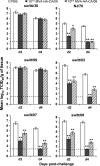Modified vaccinia virus Ankara expressing the hemagglutinin of pandemic (H1N1) 2009 virus induces cross-protective immunity against Eurasian 'avian-like' H1N1 swine viruses in mice
- PMID: 24373385
- PMCID: PMC4181486
- DOI: 10.1111/irv.12221
Modified vaccinia virus Ankara expressing the hemagglutinin of pandemic (H1N1) 2009 virus induces cross-protective immunity against Eurasian 'avian-like' H1N1 swine viruses in mice
Abstract
Objectives: To examine cross-reactivity between hemagglutinin (HA) derived from A/California/7/09 (CA/09) virus and that derived from representative Eurasian "avian-like" (EA) H1N1 swine viruses isolated in Italy between 1999 and 2008 during virological surveillance in pigs.
Design: Modified vaccinia virus Ankara (MVA) expressing the HA gene of CA/09 virus (MVA-HA-CA/09) was used as a vaccine to investigate cross-protective immunity against H1N1 swine viruses in mice.
Sample: Two classical swine H1N1 (CS) viruses and four representative EA-like H1N1 swine viruses previously isolated during outbreaks of respiratory disease in pigs on farms in Northern Italy were used in this study.
Setting: Female C57BL/6 mice were vaccinated with MVA/HA/CA/09 and then challenged intranasally with H1N1 swine viruses.
Main outcome measures: Cross-reactive antibody responses were determined by hemagglutination- inhibition (HI) and virus microneutralizing (MN) assays of sera from MVA-vaccinated mice. The extent of protective immunity against infection with H1N1 swine viruses was determined by measuring lung viral load on days 2 and 4 post-challenge.
Results and conclusions: Systemic immunization of mice with CA/09-derived HA, vectored by MVA, elicited cross-protective immunity against recent EA-like swine viruses. This immune protection was related to the levels of cross-reactive HI antibodies in the sera of the immunized mice and was dependent on the similarity of the antigenic site Sa of H1 HAs. Our findings suggest that the herd immunity elicited in humans by the pandemic (H1N1) 2009 virus could limit the transmission of recent EA-like swine HA genes into the influenza A virus gene pool in humans.
Keywords: Avian-like; cross-protection; hemagglutinin; influenza; pandemic (H1N1) 2009; transmission.
© 2013 The Authors Influenza and Other Respiratory Viruses Published by John Wiley & Sons Ltd.
Figures



Similar articles
-
Modified vaccinia virus Ankara encoding influenza virus hemagglutinin induces heterosubtypic immunity in macaques.J Virol. 2014 Nov;88(22):13418-28. doi: 10.1128/JVI.01219-14. Epub 2014 Sep 10. J Virol. 2014. PMID: 25210172 Free PMC article.
-
Computationally optimized broadly reactive vaccine based upon swine H1N1 influenza hemagglutinin sequences protects against both swine and human isolated viruses.Hum Vaccin Immunother. 2019;15(9):2013-2029. doi: 10.1080/21645515.2019.1653743. Hum Vaccin Immunother. 2019. PMID: 31448974 Free PMC article.
-
A pandemic influenza H1N1 live vaccine based on modified vaccinia Ankara is highly immunogenic and protects mice in active and passive immunizations.PLoS One. 2010 Aug 16;5(8):e12217. doi: 10.1371/journal.pone.0012217. PLoS One. 2010. PMID: 20808939 Free PMC article.
-
[Swine influenza virus: evolution mechanism and epidemic characterization--a review].Wei Sheng Wu Xue Bao. 2009 Sep;49(9):1138-45. Wei Sheng Wu Xue Bao. 2009. PMID: 20030049 Review. Chinese.
-
Influenza virus vaccines: lessons from the 2009 H1N1 pandemic.Curr Opin Virol. 2011 Oct;1(4):254-62. doi: 10.1016/j.coviro.2011.08.002. Curr Opin Virol. 2011. PMID: 22125588 Free PMC article. Review.
Cited by
-
Immunity and Protective Efficacy of a Plant-Based Tobacco Mosaic Virus-like Nanoparticle Vaccine against Influenza a Virus in Mice.Vaccines (Basel). 2024 Sep 26;12(10):1100. doi: 10.3390/vaccines12101100. Vaccines (Basel). 2024. PMID: 39460267 Free PMC article.
-
Viral vector-based influenza vaccines.Hum Vaccin Immunother. 2016 Nov;12(11):2881-2901. doi: 10.1080/21645515.2016.1210729. Epub 2016 Jul 25. Hum Vaccin Immunother. 2016. PMID: 27455345 Free PMC article.
-
Poxvirus Host Range Genes and Virus-Host Spectrum: A Critical Review.Viruses. 2017 Nov 7;9(11):331. doi: 10.3390/v9110331. Viruses. 2017. PMID: 29112165 Free PMC article. Review.
-
Modified vaccinia virus ankara (MVA) as production platform for vaccines against influenza and other viral respiratory diseases.Viruses. 2014 Jul 17;6(7):2735-61. doi: 10.3390/v6072735. Viruses. 2014. PMID: 25036462 Free PMC article. Review.
-
Cross-protection against European swine influenza viruses in the context of infection immunity against the 2009 pandemic H1N1 virus: studies in the pig model of influenza.Vet Res. 2015 Sep 24;46:105. doi: 10.1186/s13567-015-0236-6. Vet Res. 2015. PMID: 26404790 Free PMC article.
References
-
- Castrucci MR, Donatelli I, Sidoli L, et al. Genetic reassortment between avian and human influenza A viruses in Italian pigs. Virology. 1993;193:503–506. - PubMed
Publication types
MeSH terms
Substances
Grants and funding
LinkOut - more resources
Full Text Sources
Other Literature Sources
Medical

